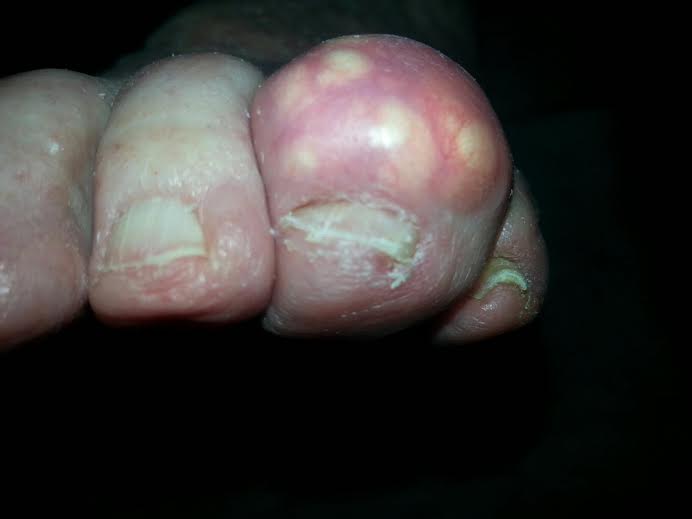Gout Treatment
The initial aim of gout treatment is to settle the symptoms of an acute attack.[35] Repeated attacks can be prevented by different drugs used to reduce the serum uric acid levels.[35] Options for acute gout treatment include nonsteroidal anti-inflammatory drugs (NSAIDs), colchicine and steroids,[2] while options for prevention include allopurinol, febuxostat and probenecid. Lowering uric acid levels can cure the disease.[6]
NSAIDs
NSAIDs are the usual first-line gout treatment, and no specific agent is significantly more or less effective than any other.[2] Improvement may be seen within four hours,but treatment is recommended for one to two weeks.[2][6] They are not recommended, however, in those with certain other health problems, such as gastrointestinal bleeding, renal failure, or heart failure.[37] While indomethacin has historically been the most commonly used NSAID, an alternative, such as ibuprofen, may be preferred due to its better side effect profile in the absence of superior effectiveness.[19] For those at risk of gastric side effects from NSAIDs, an additional proton pump inhibitor may be given.[38]
Colchicine
Colchicine is an alternative for those unable to tolerate NSAIDs.[2] Its side effects (primarily gastrointestinal upset) limit its usage.[39] Gastrointestinal upset, however, depends on the dose, and the risk can be decreased by using smaller yet still effective doses.[19] Colchicine may interact with other commonly prescribed drugs, such as atorvastatin and erythromycin, among others.[39]
Steroids
Glucocorticoids have been found as effective as NSAIDs[40] and may be used if contraindications exist for NSAIDs.[2] They also lead to improvement when injected into the joint; a joint infection must be excluded, however, as steroids worsens this condition.[2]
Pegloticase
Pegloticase (Krystexxa) was approved in the USA to treat gout in 2010.[41] It is an option for the 3% of people who are intolerant to other medications.[41] Pegloticase is administered as an intravenous infusion every two weeks,[41] and has been found to reduce uric acid levels in this population.[42]
Prophylaxis
A number of medications are useful for preventing further episodes of gout, including xanthine oxidase inhibitor (including allopurinol and febuxostat) and uricosurics (including probenecid and sulfinpyrazone). They are not usually commenced until one to two weeks after an acute attack has resolved, due to theoretical concerns of worsening the attack,[2] and are often used in combination with either an NSAID or colchicine for the first three to six months.[6] They are not recommended until a person has had two attacks of gout,[2] unless destructive joint changes, tophi, or urate nephropathy exist,[5] as medications have not been found cost effective until this point.[2] Urate-lowering measures should be increased until serum uric acid levels are below 300–360 µmol/l (5.0–6.0 mg/dl), and are continued indefinitely.[2][6] If these medications are being used chronically at the time of an attack, discontinuation is recommended.[3] If levels cannot be brought below 6.0 mg/dl and there are recurrent attacks, this is deemed treatment failure or refractory gout.[43] Overall, probenecid appears less effective than allopurinol.[2]
Uricosuric medications are typically preferred if undersecretion of uric acid, as indicated by a 24-hour collection of urine results in a uric acid amount of less than 800 mg, is found.[44] They are, however, not recommended if a person has a history of kidney stones.[44] In a 24-hour urine excretion of more than 800 mg, which indicates overproduction, a xanthine oxidase inhibitor is preferred.[44]
Xanthine oxidase inhibitors (including allopurinol and febuxostat) block uric acid production, and long-term therapy is safe and well tolerated, and can be used in people with renal impairment or urate stones, although allopurinol has caused hypersensitivity in a small number of individuals.[2] In such cases, the alternative drug, febuxostat, has been recommended.[45]
Prognosis
Without gout treatment, an acute attack of gout usually resolves in five to seven days; however, 60% of people have a second attack within one year.[1] Those with gout are at increased risk of hypertension, diabetes mellitus, metabolic syndrome, and renal and cardiovascular disease, thus are at increased risk of death.[6][46] This may be partly due to its association with insulin resistance and obesity, but some of the increased risk appears to be independent.[46]
Without treatment, episodes of acute gout may develop into chronic gout with destruction of joint surfaces, joint deformity, and painless tophi.[6] These tophi occur in 30% of those who are untreated for five years, often in the helix of the ear, over the olecranon processes, or on the Achilles tendons.[6] With aggressive treatment, they may dissolve. Kidney stones also frequently complicate gout, affecting between 10 and 40% of people, and occur due to low urine pH promoting the precipitation of uric acid.[6] Other forms of chronic renal dysfunction may occur.[6]






